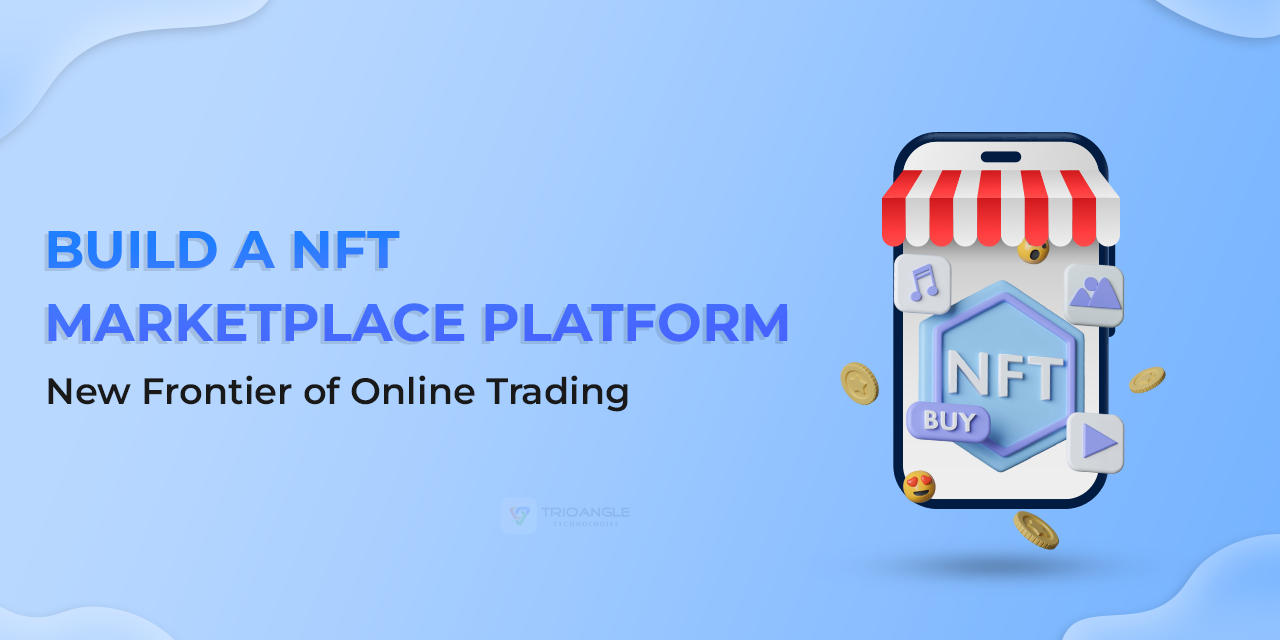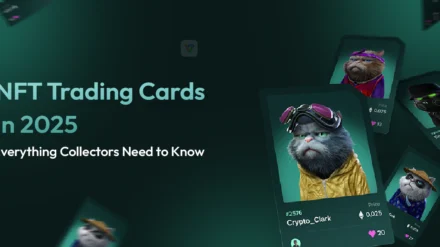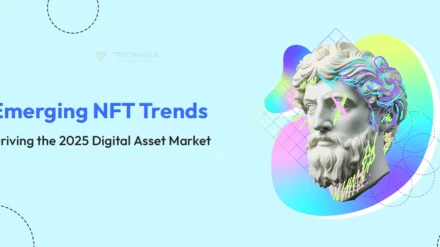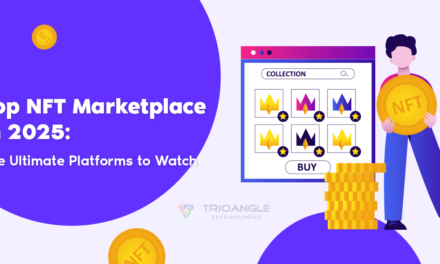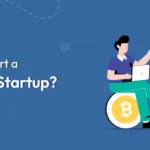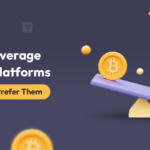The Future of NFT Marketplaces isn’t digital… it’s dynamic, decentralized, and deeply transformative. As entrepreneurs rush to build a NFT marketplace platform, the rules of engagement are evolving fast.
From AI-powered personalization to cross-chain interoperability, what once looked experimental is now core to NFT marketplace development.
This blog breaks down the next wave of innovation not as hype, but as strategy.
Whether you’re eyeing NFT trading platforms or exploring how to scale as a founder, this is your blueprint for the future. Let’s decode what’s next and how you can lead it.
The Evolution of Online Trading: From eCommerce to Token Economy
Online trading began with eCommerce centralized, bank-dependent, and often limited by geography. Businesses sold goods online, buyers paid in fiat, and platforms took hefty fees. But over time, this model showed cracks. It lacked transparency, user control, and true ownership. That’s when blockchain technology changed everything.
Today, NFT trading platforms are redefining ownership in the digital space. Unlike traditional marketplaces, NFTs let users own, verify, and resell digital assets. Like art, real estate, music, and more. This shift signals a broader transformation from digital buying to tokenized economies.
The Future of NFT Marketplaces lies in this transition.
“Curious about how tokens are actually built? Dive into our full Token Development guide now!”
Web3 trading replaces middlemen with smart contracts. Decentralized NFT marketplaces now give users direct control over their assets. Entrepreneurs looking to build a NFT marketplace platform… must focus on transparency, scalability, and wallet integration. It’s not just about tech it’s about trust and true value exchange.
Build a NFT Marketplace platform has now become a core part of blockchain-based marketplaces. This evolution invites a new generation of NFT entrepreneurs ready to disrupt industries. Whether you’re learning how to trade NFTs or planning your entry into online NFT trading.
One thing is clear: token economies are shaping the next era of digital commerce.
Why Online Trading Is Outdated — And Ripe for Disruption
From Centralized Gatekeepers to Peer-to-Peer Protocols
Amazon, eBay, and Alibaba have dominated internet commerce for decades. These platforms control every part of the transaction. pricing, data, payment flow, and even user visibility. Creators and sellers hand over value in exchange for access to customers. Buyers don’t own their purchases beyond platform rules. It’s a closed loop.
Now compare that to NFT trading platforms. With Web3 trading, control shifts to users. Smart contracts replace middlemen. Transactions are transparent, trustless, and direct. This is where NFT Marketplace platform Development changes the game.
Entrepreneurs can now build a NFT Marketplace platform without locking users into a single system. It’s peer-to-peer by design. No middleman, no gatekeeping.
Assets Without Ownership? The Problem NFTs Are Fixing
Today’s digital assets ebooks, music, even in-game items are licensed, not owned. You pay to access, not to own.
Lose the account or platform? You lose the asset. That’s a huge flaw.
NFTs fix this. They turn digital usage rights into real, tradable property.
When you own an NFT, you own a unique, verifiable asset. You can resell it, trade it, or hold it forever. This is why many NFT Marketplace Companies are now build a NFT Marketplace Platform focused on creator rights and user control.
It’s not just about tech… it’s about giving digital assets real-world value.
Global Liquidity Through Tokenization
Old trading systems work 9–5 and stop at borders. Tokenization changes that. Assets become global, divisible, and available 24/7. Anyone can trade, anytime, anywhere.
This opens up bold new models. Think fractional ownership of music rights or real estate. Think global micro-investing. A decentralized NFT marketplace doesn’t just sell… it unlocks liquidity.
Entrepreneurs who want to build a NFT marketplace platform must embrace this. Because the Future of NFT Marketplaces lies in borderless value exchange.
As the NFT marketplace for entrepreneurs grows, so do opportunities.
Tokenization is not just a trend… It’s the new trading foundation. Ready to trade without borders?
The Core Elements to Build a NFT Marketplace Platform
To build a NFT Marketplace platform is not about copying what’s already out there. It’s about understanding the foundational architecture. technical, functional, and economic. If you’re looking to build a NFT marketplace platform that lasts, here are the four pillars that must guide your development.
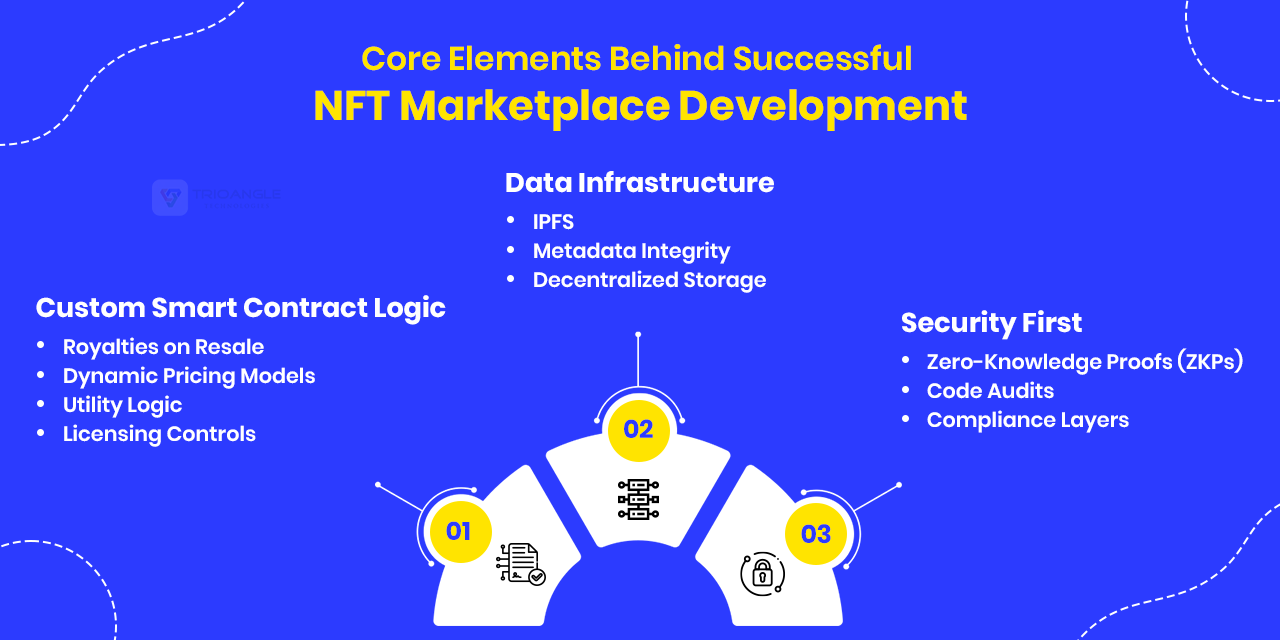
Custom Smart Contract Logic: Beyond Just Minting NFTs
Most marketplaces start with simple minting. But the future belongs to platforms that offer programmable ownership and automated functionality through custom smart contracts.
Here’s why that matters:
- Royalties on Resale: Artists and creators want recurring income. Hardcoding royalty distribution into smart contracts ensures they earn on every secondary sale.
- Dynamic Pricing Models: You can go beyond fixed pricing. Auctions, bonding curves, Dutch auctions — all need custom logic.
- Utility Logic: Some NFTs unlock real-world benefits, like memberships or rewards. This requires smart contracts that track usage and conditions.
- Licensing Controls: Want to allow someone to “rent” an NFT? You’ll need logic to define and enforce temporary ownership.
Smart contracts, so, are business rules in code. They’re what let you offer new value in a Web3 trading environment.
Data Infrastructure: IPFS, Metadata, and Decentralized Storage
NFTs store data in two places: on-chain and off-chain. The media images, videos, 3D models usually live off-chain due to cost. But if this data is hosted centrally, it can vanish.
That’s where IPFS (InterPlanetary File System) and decentralized databases like Arweave come in:
- IPFS uses content-addressing. This means even if the server changes, the content can always be found using its hash.
- Metadata Integrity: Proper marketplaces hash their metadata and store proofs on-chain. This ensures no one can secretly change an NFT’s info.
- Permanence: Decentralized storage keeps NFTs alive even if your company doesn’t survive. That builds long-term trust.
To lead in NFT marketplace development… you should build a NFT Marketplace Platform that must respect data sovereignty and decentralization.
Security First: Compliance, Auditability & Cryptographic Integrity
Security isn’t a checklist. It’s the backbone of every interaction. And it’s also a competitive advantage for the best NFT marketplace 2025.
Modern platforms protect users through:
- Zero-Knowledge Proofs (ZKPs): These allow users to prove something (like age, balance, or asset ownership) without revealing private data.
- Code Audits: External security firms audit your smart contracts to catch bugs or vulnerabilities before hackers do.
- Compliance Layers: KYC/AML modules can be embedded without sacrificing decentralization. This is key when dealing with regulated assets like real estate NFTs or financial instruments.
If your NFT trading platform can’t guarantee security, no amount of innovation will matter.
Business Logic Meets Tech Stack: Aligning Tools with Vision
Many startups make the mistake of choosing tools based on hype. Instead, your tech stack must serve your product strategy.
Ask:
- Who is your target audience — artists, gamers, enterprises? Choose blockchains they already trust.
- Are you focused on speed and low fees? Then go Layer 2 or sidechains (Polygon, Arbitrum, Avalanche).
- Need mobile users? Then offer wallet integrations like WalletConnect or Phantom, not just MetaMask.
- Want to launch new NFT collections? Add in-house launchpads and white-label solutions.
The stack you pick affects everything: performance, user experience, scalability, even your revenue model. For NFT marketplace companies, aligning business goals with tech infrastructure is non-negotiable.
How Companies Use NFT Trading Platforms to Monetize Innovation
Real-World Case Studies from Different Industries
NFTs are no longer for art or gaming. Businesses across sectors are using them to solve real problems and create new revenue.
- Real Estate: Properties are being tokenized into NFTs. This lets investors buy shares in buildings, lowering the barrier to entry and improving liquidity.
- Retail & Loyalty: Brands use NFTs as loyalty rewards. These digital tokens unlock discounts, early access, or exclusive drops.
- Digital Fashion: Fashion houses now sell virtual wearables. Buyers can try them on via AR and showcase their collections in the metaverse.
- Education: Institutions issue NFT-based certificates. They’re tamper-proof, easily shareable, and verifiable across borders.
Each of these use cases proves one thing… NFT marketplace development enables more than just trading. It builds new business models.
“Wondering how NFT marketplaces really make money? Explore the full revenue model in this blog!”
Platform-as-a-Product: Earning via Commission, Subscriptions & Launchpads
If you’re looking to build a NFT marketplace platform, your revenue model matters. Here are some popular ways NFT marketplace companies generate income:
- Transaction Fees: A small cut from each sale on the platform.
- Launchpads: Helping creators mint and promote collections. Platforms charge for this.
- White-Label Services: Offering branded versions of the marketplace to others.
- Premium Subscriptions: Advanced analytics, featured listings, or exclusive access.
These models turn platforms into profit engines.
Decentralization = Trust + Market Expansion
Decentralized NFT marketplaces give users control. No single party holds the data, assets, or rules. This boosts trust.
It also allows:
- Lower entry costs
- Open access across countries
- Real-time, 24/7 trading
That’s why many say Web3 trading will define the future of NFT marketplaces.
In this fast-changing space, entrepreneurs must think beyond just building. They must think about creating lasting value for users, creators, and themselves.
Online NFT trading is no longer just a trend. It’s a new infrastructure.
The Future of NFT Marketplaces: What’s Next in the Digital Trading Revolution
The digital ownership era is only getting started. As we move toward 2026, the future of NFT marketplaces is being shaped by intelligent automation… real-world integrations, community-led governance, and a truly borderless trading experience.
Entrepreneurs planning to build a NFT marketplace platform… must understand these next-gen features not as options. but essentials for survival and scale.
AI-Integrated Marketplaces: Personalized Discovery Meets Ownership
AI is set to become the silent engine behind NFT Trading Platforms. But we’re moving beyond basic filters and search bars. The next wave will offer dynamic, intelligent NFT discovery.
- AI curates for each user:
Algorithms will learn from browsing behavior, wallet activity, and engagement history… to serve up hyper-relevant NFT collections. - Context-aware search:
Imagine typing “digital sneaker drop + female creator + trending this week”. and receiving curated results that’s where AI is heading. - Predictive analytics for creators:
- Creators will know the best time to drop, price, or promote based on real-time AI forecasts.
- Fraud detection in real-time:
AI will flag suspicious listings or plagiarized assets before they hit the marketplace.
This layer of intelligence will not only streamline online NFT trading… but also push marketplaces closer to personalized e-commerce experiences something legacy platforms lack.
Phygital Trading: Bridging Real-World Assets and NFTs
The line between physical and digital is fading fast. NFT entrepreneurs are now launching Blockchain-based marketplaces where physical assets carry digital twins.
- Smart Packaging:
Physical items shipped with scannable chips that connect to NFTs for proof of authenticity. - Inventory Tokenization:
Retailers mint NFTs for unsold stock, offering fractional access or future utility. - Event NFTs:
Concert or conference tickets as NFTs now double as digital memorabilia or unlockables.
These aren’t just gimmicks… they add traceability, authenticity, and secondary-market value. If you’re building for long-term use cases, phygital commerce is the lane to explore.
DAO-Governed NFT Platforms and Decentralized Arbitration
Today’s creators and traders demand control and fairness. This is why DAOs (Decentralized Autonomous Organizations) are becoming the operational backbone of the best NFT marketplace 2025 models.
- Protocol decisions:
From royalty structure to curation rules are voted on by NFT holders. - Arbitration on-chain:
Disputes (like copyright or delivery issues) are resolved via transparent smart contracts… or juror-based DAO models. - Incentive loops:
DAO participants earn tokens for contributing to moderation, development, or marketing… It ensures platform longevity.
For entrepreneurs, DAO integration isn’t just a tech flex. It builds community-led stickiness and aligns long-term vision with user trust.
Global Interoperability — Why Future Trading is Borderless
The future of NFT marketplaces is multi-chain, multi-format, and multi-lingual. Isolation kills growth. The focus now is on seamless interoperability.
- Cross-chain minting:
Creators mint once, and the NFT works across Ethereum, Solana, Polygon, and more. - Universal metadata standards:
Interoperable metadata ensures utility and presentation are consistent across dApps. - Language & compliance layers:
AI-driven translation and jurisdiction-aware compliance will open global markets… even in tightly regulated regions.
Web3 is not just “decentralized”… it’s de-siloed. NFT Marketplace Companies that enable borderless access will lead global trading volume in 2026 and beyond.
Conclusion
We’re entering a new era where NFT marketplaces are no longer just platforms… they’re ecosystems. Built with intelligence, governed by communities, and powered by ownership… The next generation of NFT trading platforms will redefine how we trade, collaborate, and monetize digital and real-world value. From smart contracts to governance, every layer matters in NFT marketplace development.For those aiming to build a NFT marketplace platform, the opportunity isn’t in the tech… it’s in understanding the shift. From phygital assets to AI curation and decentralized governance, innovation favors those who move early and build right. The revolution is already unfolding and the smartest NFT marketplace for entrepreneurs will be the one that gets there first. Will it be yours?

